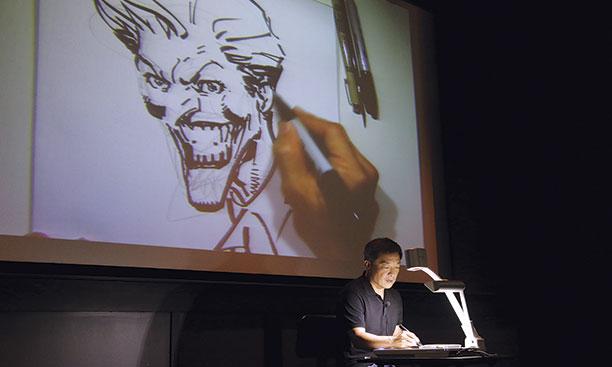Dozens of events were offered as the Lewis Arts complex made its debut in early October. PAW sampled a few.

Music and Sculpture Tour with Sō Percussion
On a warm October afternoon, the sound of bells, drums, and other percussive instruments filled the air. Outside “The Hedgehog and the Fox,” the massive steel Richard Serra sculpture near Fine Hall, a crowd gathered to watch. It was there that Sō Percussion was playing the first piece on its music and sculpture tour.
About 50 people joined Sō Percussion as the group visited six prominent sculptures on campus. At each one, the musicians performed an original five-minute piece created by a Princeton composer in response to that artwork. Unsuspecting students looked on as the group banged on gongs while standing in the Woodrow Wilson School fountain. In front of the University Art Museum, the sound was different, coming from musical instruments made from spoons, knives, and forks. By Ezra Austin ’19

Theatre for One
After about 40 minutes of waiting to enter a large, mysterious black box, I was called to begin my experience of the Theatre for One. When I entered, I was confronted by a tall white man who introduced himself as David.
David began to tell me he believed that since there is a Black Lives Matter movement, there should be a White Lives Matter movement, too; since there is an NAACP, there should be an NAAWP. He said affirmative action should be abolished, and cautioned that if we diverged from the values of our white founders, our future as a nation would be threatened.
Although I reminded myself that this was part of a show and not an actual conversation, the actor’s performance and the lack of any audience-stage division made me forget that it was all scripted. The experience took on a particularly eerie quality when the actor addressed me directly: “Our movement is growing, and it’s growing quickly. Soon you, too, will join.”
As the curtain closed on his grinning face, I realized how powerful the five-minute performance had been. I had felt uncomfortable and threatened. And I walked away with a sense that the larger political reality was not as far removed from my personal life as it may seem. By Layla Malamut ’18

Jim Lee: From Secret Comic Book Fan to Acclaimed Artist
Celebrated comic-book artist and publisher Jim Lee ’86 often sees fans wearing his work on their T-shirts. When he was a student at Princeton, however, he was embarrassed to be seen with comic books, describing the comics scene as a secret society that very few appreciated – including his parents.
“They had sent me to all of these expensive schools, and here I was drawing people wearing underwear outside their clothes,” Lee told an audience of about 115 at the James M. Stewart ’32 Theater.
Lee expected to obey the wishes of his parents and become a surgeon until artist Fontaine Dunn, who led a visual-arts class at Princeton his senior year, encouraged him to pursue art as a career. He had been a longtime comic-book fan after he had used them to teach himself English as a child of Korean immigrants.
Lee gave himself a year after graduation to pursue comic illustration and never stopped, working for comic giants DC and Marvel and forming his own publishing company. “I was pretty terrified to take chances,” he said. “But if you’re in your 20s, those are the years to do everything wrong and make those mistakes.” By Ellie Schwartz ’20
Peaceful Nassau In Thee We Sing
Listeners filled a room of American art at the University art museum to hear a concert of 18th-century music and some modern variations, featuring works that ranged from a choral ode from “A Dialogue on Peace” to a reading of Phillis Wheatley’s 1773 poem “Hymn to the Morning.” Much of the music complemented objects in the museum, such an English flute solo dedicated to Lady Coventry, whose portrait can be found in the museum; and the tenor solo of “A Toast to Washington,” whose likeness is found in statue and painted form in the building.
The concert included contemporary pieces inspired by 18th-century instruments and composition styles. “She,” composed for the event by Ninfea Cruttewell-Reade, a Ph.D. student in music composition, was a soprano solo of different combinations of vowels and consonants from the word “she” – ranging from soothing “shh” noises to rapid “h-h-h” to smooth “eee” sounds. Four musicians accompanied Cruttewell-Reade on a collection of drinking glasses, using their wet fingers to create tones along the rims. This technique was a popular form of music making in the 18th century, as in Benjamin Franklin’s “glass harmonica” invention, a precursor to the wind instrument played today, in 1761. By Julia Case-Levine ’18
